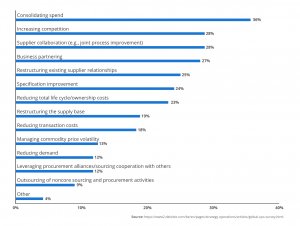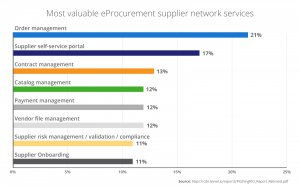Every expenditure must be carefully considered in business. However, not all spending decisions carry the same implications. In order to make sure your procurement department is making the best choices possible, it is important to understand the nuances related to indirect spend management compared with direct spend management.
Indirect and Direct Spend
In procurement, there are two major classifications for expenditures. Direct spend refers to goods or services that relate specifically to the manufacturing process. This could include raw materials, hardware, subcontracting manufacturers, and more. These are goods and services that you need in order to produce a viable product for clients.
By contrast, indirect spend refers to goods or services that do not directly link back to the manufacturing process. Some people think of indirect spend as the cost of doing business. This can include janitorial services, cleaning supplies, technology, office supplies, and more. These items are not used to create a product, but they are vital to the company’s functionality at large.
Obviously, many procurement departments focus on direct spend. After all, if you do not have high-quality raw goods and efficient manufacturing processes, then you will not have a product to sell. However, it is a mistake to let indirect spend take a back seat. Both types of spend are essential for a solvent business model, with consolidating spend ranking as a top business priority, according to the Deloitte CPO Survey.
The Importance of Indirect Spend Management
Indirect spend management should carry far more weight in most procurement departments. The reason is twofold. First, the value of the products and services for indirect spend is more salient than most people realize. Second, these costs can quickly spiral out of control, creating tail spend that negatively impacts your bottom line.
To the first point, indirect spend may not tie directly to your end product. However, this spend still affects your operation. Just consider an indirect spend category like office supplier. If you do not invest in the right supplies, then your operation may not be as productive as it should be as these are products that employees need in order to retain their productivity.
Moreover, without indirect spend management, you can lose a lot of money. When it comes to raw materials, there is often a great emphasis on quality. This ensures that you get the best value. Contracts are carefully planned, measured, and enforced to control costs. For indirect spend, too many procurement departments are haphazard. They do not thoroughly vet expenditures, which can lead to poor quality, lackluster delivery, and overstocking.
Fortunately, these problems are easy to control. The key is to systematically employ indirect spend management purposefully.
How to Improve Your Indirect Spend Management
In order to improve your indirect spend management, you need concrete, actionable measures. Consider these tips to get your procurement department moving in the right direction.
1. Vendor Management
Developing good relationships with vendors can be a great tool in indirect spend management. By looking at your vendors as partners, you can establish joint goals that are mutually beneficial. Of course, this does not mean that you should be complacent with vendors, but it does mean that you need to employ softer skills to close deals. In another blog, we talked about some of the benefits of vendor management.
To help manage your vendors, you can rely on software solutions. According to data from PWC, vendor sourcing and management is the second strategic priority for purchasing departments. Companies embracing strategic processes such as contract management and vendor relationship management also increased to 36% in 2020.
2. Automation
Automation has taken hold in most other areas of business operation, but procurement departments have been slow to get on board. Automation of procure-to-pay processes improved year to year but there is still a long way to go.
When procurement is automated, there is wider accessibility to indirect spend management. Order requests can be automatically generated based on demand within the company, thus minimizing the amount of time needed to monitor these needs. It can also reduce excess purchases.
3. Education
When it comes to indirect spend, a large portion of the problem is simply a lack of knowledge. These ancillary needs are not always readily discussed, and some employees may lack knowledge of purchasing processes for the likes of cleaning supplies and office products.
Education should be multifaceted, and it should include concrete metrics for your procurement team to understand. These metrics can help delineate performance requirements, contract compliance, cost-effectiveness, and more. Simply defining what needs you have and why those needs matter can help employees make better decisions regarding your indirect spend.
4. Contract Review
Too often, procurement departments are not proactive about their indirect spend contracts. This is a mistake. It is important to actively review your contracts in this area, ensuring that you are getting the best services, products, and prices. We’ve previously discussed the importance of contract visibility in your procurement process.
Contract management solutions can play a key role in helping organizations improve spend management. You should seek quotes from other vendors in order to see how the contract compares to the market. Without reviewing your contract, you cannot possibly have enough information to negotiate in your favor. If vendors suspect you are complacent about your contracts, they are more likely to be complacent in the delivery of your goods or services.
Conclusion
Indirect spend management plays a critical role in your company, and you need to make sure your procurement department is giving it the attention it deserves. Indirect spend may only tangentially be linked to your final product, but it is intimately connected to your bottom line. These tips are practical measures to start managing your indirect spend today.





